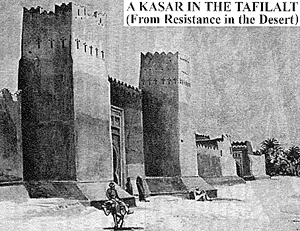
Kasarians
The Kasar was common to all the oases in the region. They varied greatly in size from small walled collections of a few buildings to huge city fortresses. Within the Kasars of the region, the social structure of the inhabitants can be divided into six major sub groups:: Sherifs; Marabouts; Ahrar; Haratin; Slaves; and Jews.
Sherifs were those who were accepted as descendents of The Prophet. They were usually addressed as Mulay and widely scattered throughout Morocco. They were politically influential men with a high social standing enjoying the privileges and immunities the position brought them. Marabouts were descendents of saints, holy personages responsible for maintaining the tombs. Often they established Koranic schools, places of arbitration, sanctuaries, religious brotherhoods and pilgrimage destinations. These special establishments were generically known as zawiya, the head of which was a sheik, often a living saint in his own right. Marabouts were addresses as Si, or Sidi.
Marabouts and sherifs were not mutually exclusive and provided he qualified, a man could hold both positions. The characteristic that separated these two categories from the rest of the inhabitants was the possession of “Baraka” or presence of divine grace. The most appropriate western concept of this division socially would be to aristocracy. Members of these two groups were usually required to marry within their lineage to prevent the loss of the holy descent lineage.
Ahrar were the largest groups in the Kasars. They were the land-owning farmers in and around the oases. Ahrar literally means ‘freeborn’. They were not tribal (with a few exceptions) but did hold strong family lineages. They considered themselves to be more white than the lower class haratin, but whiteness was more defined by family lineage than by skin color. So even if an Ahrar intermarried with racially darker skinned spouse, the child was a ‘white Arab or Berber’ if his father was.
Haratin were mostly dark skinned of Negroid ancestry. Descended either from the original Neolithic inhabitants of the region (before the Moors or Arabs came) or from inter-breeding with West Africans. They were not slaves. They were the “working class”, the serfs of the “landed gentry” Ahrar. They worked usually for a fifth (or some portion) of the crop yield. They rarely owned any land and lived in the same quarter within the Kasar. They did not trace their family lineage beyond two or three generations. The haratin were a major portion of the sedentary populations, as big as or larger than the Ahrar.
Slave ownership was diapering rapidly at the end of the nineteenth century due to the dwindling West African slave trade. What few slaves remained in the Kasars were usually household slaves of the top two groups who had become integrated with their owners’ family and had strong personal ties to them. The majority of what slaves there were in the region belong to the semi nomadic tribes already described.
Jews occupied their own quarter within the Kasars, called the mallah. They did not operate within the Muslim system but neither were they persecuted by them. They did require the protection of a Muslim patron who represented them in dealings with the Muslim community. They were specialists in commerce, metal smithing (including gun smithing) and leather working and shoe making.
More Resistance in the Desert Part I
-
Introduction
Invasion of Tidikelt
The Resistance Ferments
Problems of Supply
Overview of the Inhabitants of SE Morocco
Military and Political System of Dawi Mani' and Ait Atta
Kasar Inhabitants
Native Firepower in the Desert
French Forces in North Africa
Back to Table of Contents -- Courier #80
To Courier List of Issues
To MagWeb Master Magazine List
© Copyright 2000 by The Courier Publishing Company.
This article appears in MagWeb (Magazine Web) on the Internet World Wide Web.
Other military history articles and gaming articles are available at http://www.magweb.com